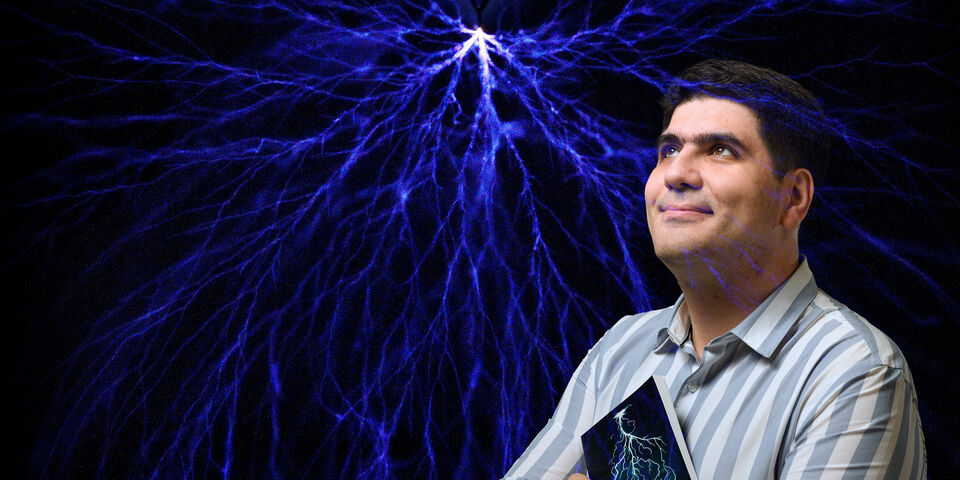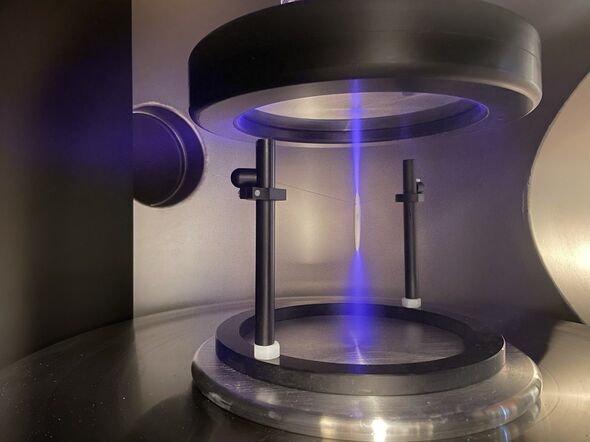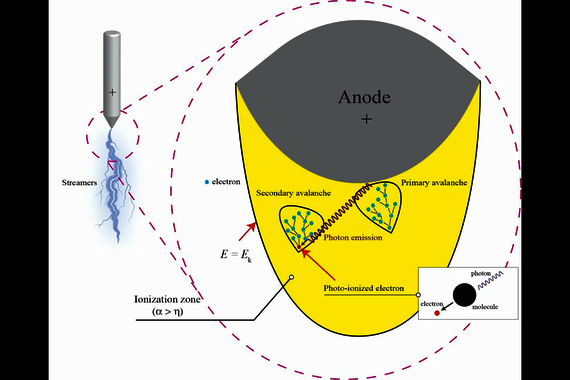Home Stretch | The source of lightning
Every second the earth is struck by lightning dozens of times. You would think that by now this common phenomenon would be an open book to us. Yet the precise genesis of a lightning bolt, says doctoral candidate Shahriar Mirpour, remains a mystery. At the Elementary Processes in Discharges (Applied Physics) lab he managed to find out more.
In principle, we know how lightning works: electrons in a thundercloud are accelerated as a result of differences in the electrical charge that have built up; moving at speed they collide with molecules in the air, releasing yet more electrons. In this snowball effect, something called a plasma channel is created: a stream of charged particles capable of conducting a strong electric current. As soon as a plasma channel connects with the ground (or with another cloud), a lightning bolt is produced: a short electrical discharge averaging 30 kiloampere.
But in practice it is not that simple, writes Iranian doctoral candidate Shahriar Mirpour in his thesis. First measured in 1945 from an American B25 bomber and later using sophisticated weather balloons, the electric fields in thunderclouds are evidently far too weak to cause such a cascade of electrons. “Even if you factor in the lower air pressure and higher humidity in thunderclouds this remains the case; both of these reduce what is called the breakdown voltage. So actually the incipient stage of lightning is still a mystery.”
Ice particles
Given this, it is suspected that ice particles in the thundercloud do something to the electric field, explains Mirpour. “Near the sharp point of an ice particle the electric field is supposed to be stronger, enabling an avalanche of electrons to occur here.” To test this hypothesis, he built an experimental setup in which he suspended small objects of various shapes, lengths and materials on fishing lines. These lines were hung between two plate-shaped high-voltage electrodes. Using a high-speed camera, he recorded the sparks generated.
As working with real ice particles was rather impractical - if only because in the lab they melt faster than in an icy thundercloud - Mirpour decided to produce his test particles from titanium oxide. “The electrical properties of this semi-conductor most resemble those of ice. But titanium oxide is ceramic, a tricky material to work. In the end, I spent two years producing a series of test particles ranging in length from one to eight centimeters.”
Text continues below the picture
As comparison material, this Iranian doctoral candidate used brass objects, an alloy (mixture) of mostly copper and zinc. “In principle, brass is less suited than titanium oxide to simulating ice because it conducts electricity too well.” Ironically, this proved to have little effect on the results. “So I would advise anyone doing experiments like these to use brass. It is much cheaper and took only a week to produce.”
In his experiments, Mirpour did indeed see that at much lower voltages (and thus electric field strength) sparks were generated near his imitation ice particles. “This should mean that, if you have a series of particles like these in a thundercloud, over a sufficiently great distance, these ice particles can indeed facilitate the genesis of lightning.”
He also observed that the average field strength needed reduces as the particles used are more pointed, because the electric field becomes as it were more concentrated around that point. But there is an optimum: if the pointy particles are too small, the region with raised electric field strength is too small to be able to actually accelerate electrons. According to this doctoral candidate, this implies that the exact size and distribution of the ice particles in thunderclouds is critically important in the formation of lightning.
Kilometers
That the mystery is now truly solved is a statement Mirpour dare not make. “I've looked at just one particle at a time; the conditions in the atmosphere are, of course, very different to those in our lab. Moreover, lightning is a discharge that takes place over a distance of kilometers. Working with a scale model in the lab it's always going to be difficult to make definite pronouncements.”
Once he has his doctorate, Mirpour will be looking for a job in industry. “Not only have I produced lightning during my doctoral studies, I've also learned a great deal about how to prevent discharges; relevant knowledge for a range of engineering companies, such as ASML. In any event, I hope to be able to work somewhere in the Netherlands because this is a fine country in which to live.”
In the animation below, Shahriar Mirpour shows how 'lightning' is created in the lab.




Discussion